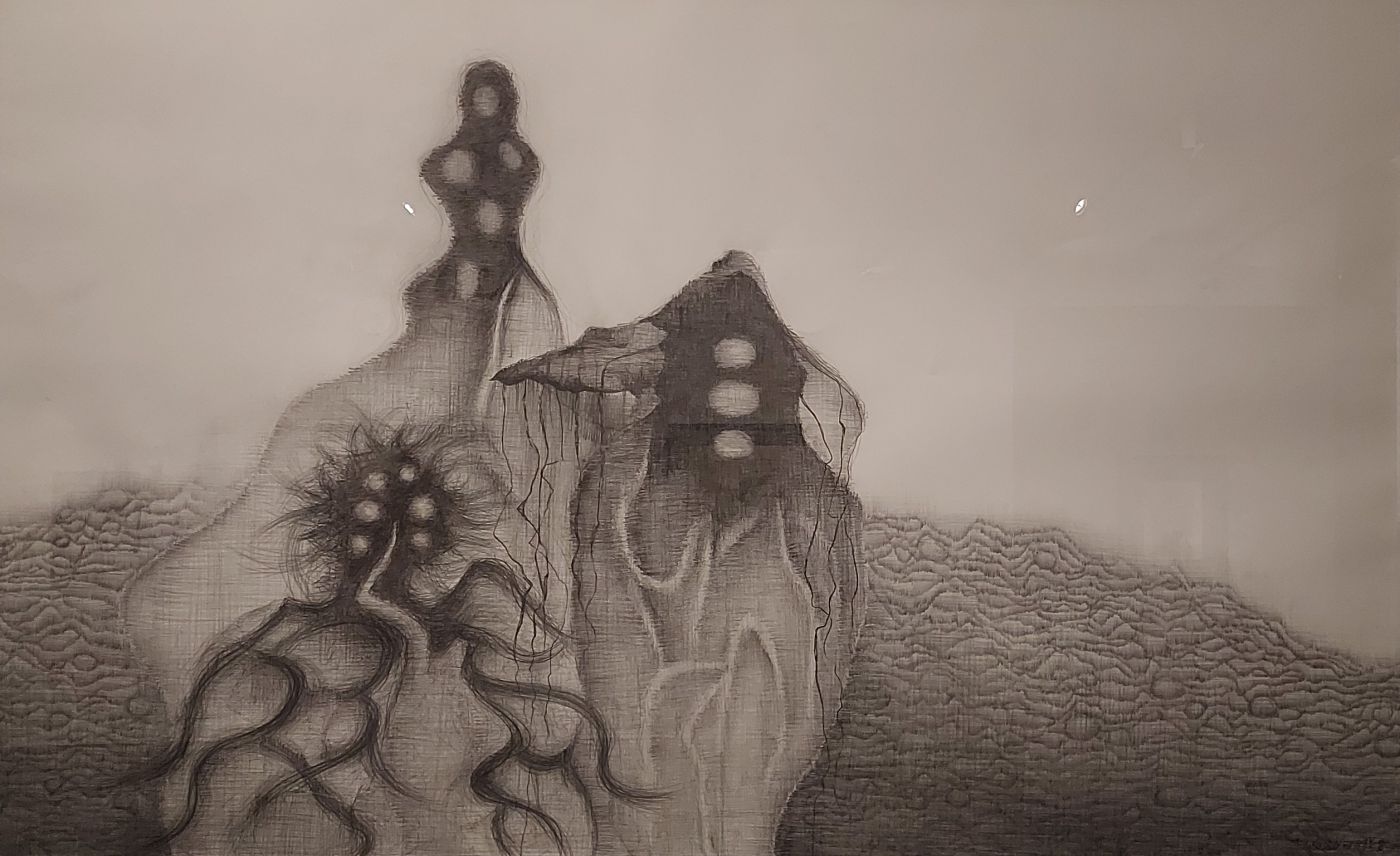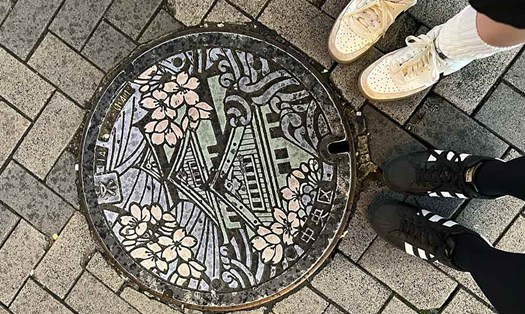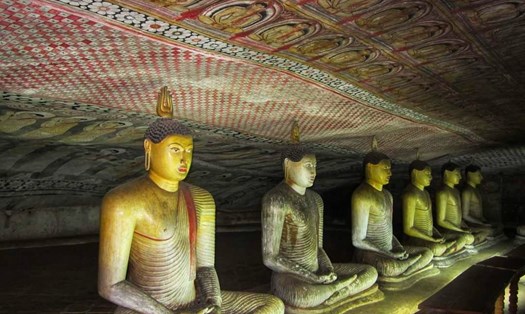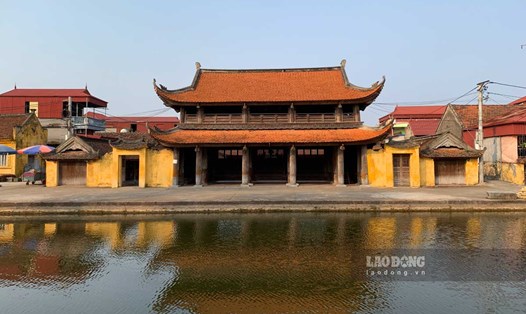The exhibition is titled “Movement in Silence”, with 2 main groups of visual works: 6 sculptures/groups and 25 paintings. While the artist chose wood as the material for the sculptures, the artist used pencil on paper for all the monochrome paintings. The paintings on the wall and the statues on the floor and in the garden give viewers a sense of the spirit and impressive working capacity of an artist nearly 80 years old.
Coming to painting before going into sculpture, after many years of creation, Katsumi Mukai no longer distinguishes between this form or that form, for him, drawing the lines of a saw on a wooden surface is no different from drawing the lines of a pencil or drawing tools on a paper surface. And although he has traveled to many places, created thousands of works, felt that he was born in this life to create, he is still humble and never thinks of himself as a talented person, but is lucky and happy to work and interact with artists as well as art materials from countries around the world.
“This time coming to Vietnam, I didn't have any thoughts or expectations. For me, artistic inspiration comes from living that life,” said artist Katsumi Mukai.
“Movement in stillness” therefore, could be the inspiration the artist receives, or it could be his own spiritual life that he wants to transform into his work.
Viewers “search” for something “moving” in the exhibition. The black and brown pencils and lines are hollow, separating shapes on a white paper background. The wooden trunks are hollowed out, twisted and stand alone in clusters or individually.
Sometimes in paintings we cannot tell whether it is a division of growth or a gradual death - of plant or animal cells. In statues we cannot tell whether it is a tree with holes and hollows carved by time or the remaining human forms. The surface of wooden statues is never flat, the pieces are "scooped" from the base to the top with very "sweet", regular indentations. One can think of the time stamp placed on it, or the sand after the tide has gone out.
Hearing and sight are considered the two most powerful senses that help people perceive the world. Fine arts focus on sight, but a great work of art is one that can touch many senses, evoking a feeling of something or an atmosphere in the viewer. Viewers are smart enough not to ask for a painting to bring them the scent of flowers, the sweetness of fruit, or the moisture of the air... but it will be extremely magical if the work makes them think of that.
The wooden sculpture installations of “Movement in Stillness” brought a real scent to the exhibition room, awakening another sense (smell) of the viewer without the need for imagination. The red color of the leftover wooden pieces spread on the floor and the fragrant smell of the wood warmed the whole room, giving us a sense of life, of the soul of the wood spreading in the air. Something very natural but very human. Art, perhaps to its end, is also to awaken us to something very natural but very human like that!

Most viewers don’t hear the saw, the chisel, the vibration as the artist carves into the wood, nor the pencil on the paper as the artist creates each painting; we probably don’t even notice it when we’re in the gallery. Each piece of material removed (from the wood) or stroke added (from the blank page) leaves its mark, and they combine to form what we see. If we look at the works “back” before they take shape, the persistent but powerful sound and movement of the artist’s body and spirit will emerge. The communion will be much greater.
Why draw on paper? Because paper is made from wood. Why wood? Katsumi Mukai explains, because wood is a material very close to human life, from household items to construction materials. Wood is also a manifestation of the spiritual life of every country in the world. For each country and cultural region, the scent of wood is different, bringing very special emotions. But more than that, when choosing wood, the artist associates natural materials with humans: "Wood is like humans, it never exists forever, at some point it will also wither and rot". Just like "our physical body can be lost, never exists forever, but the memory of it remains, and that is beauty".
Katsumi Mukai's explanation reminds us of the Japanese philosophy of Wabi Sabi (a philosophy of life that focuses on the natural, rustic, imperfect, and impermanent beauty of things), but his work makes us realize that artistic inspiration is abundant. "Personally, I feel lucky because I am in my twilight years, because there are things that I did not realize or could not do when I was young, but now I can do. I never thought I would have difficulties, it was just new experiences, new joys, new enjoyments. So I am very excited about what is coming, what will happen to us."
Art history can use the yardstick of time to generalize the creative process of an artist or a movement, an artistic period: from the initial stage, the stage of formation, stable development, to the final stage of decline, decline. But real artists seem to care little about this. For them, being able to make art, living their lives every day, every moment is precious and happy regardless of age. Even in the seemingly still silence, movements continue to take place.
Artist Katsumi Mukai was born in 1946 in Tohoku, Japan. In 1964, he went to Tokyo to study painting at the Central Academy of Fine Arts, then decided to finish the course after only half a year. In 1971, he went to London, England to study on his own and research art through museums and galleries. Since 1990, he has shifted his creative focus to wood sculpture. The exhibition "Movement in Stillness" takes place from November 15 to December 1 at the Vietnam Fine Arts Museum (Hanoi). The exhibition is part of the project of the Song May Contemporary Art Museum, curated by Vu Hong Nguyen.









